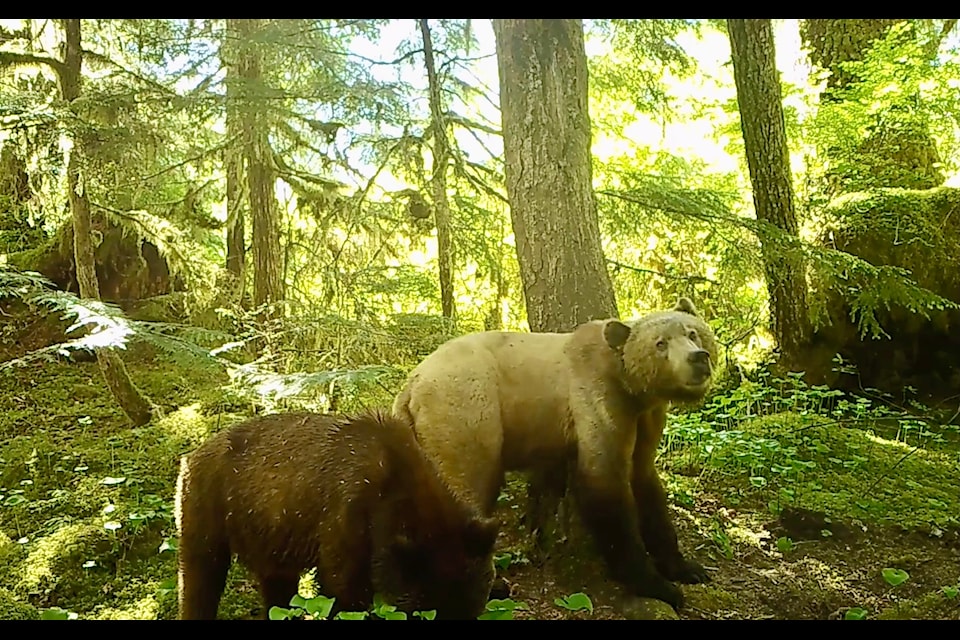A grizzly bear rewilding pilot project reached a major milestone this summer as two cubs, Isa and Arthur, orphaned in 2020 and released into the wilderness near Bella Coola in 2021, were found to be thriving.
After their mother was killed in a car accident, the Northern Lights Wildlife Society (NLWS) took in three cubs for its pilot grizzly rewilding project and provided them with care. After a little more than a year in care, the cubs were released back into the wild.
The third cub, Raven, a female, was most likely a victim of predation and died, but the second female cub Isa and the male cub Arthur are alive and well and now the subject of a video featuring trail camera footage.
Angelika and Peter Langen established the Northern Lights Wildlife Society in Smithers to rehabilitate and educate young, injured and orphaned wildlife.
"We're providing food and medical care, if needed, and protection, because they don't have a mother anymore, and the young animals need that protection. And once they reach an age they can take care of themselves, we bring them back to the areas they came from," said Angelika.
Northern Lights Wildlife Society is the only wildlife facility in North America rehabilitating and rewilding grizzly bears. They have partnered with the Grizzly Bear Foundation which made post-release monitoring of these grizzlies possible.
NLWS specializes in rewilding bears and moose, although they accept all mammals. Over her 34-year career as a trained animal keeper, Angelika has successfully rehabilitated around 850 bear cubs, mostly black bears. While she has cared for and rewilded black bears for decades, rewilding grizzlies is in its early stages.
"The grizzlies are still relatively new, and because they usually stay with their mother a bit longer (three years), we weren't 100 per cent sure that they would be okay, but it worked!" she said.
Through trail cameras set up by research scientist Dr. Lana Ciarniello, Isa and Arthur have been observed surviving multiple winters and springs and are now approximately four and a half years old. The cameras also caught Isa scent marking on a rub tree.
"For any young bear, surviving another year is a remarkable feat of resilience in a world full of natural and human dangers," said The Grizzly Bear Foundation in a recently released video describing Dr. Ciarniello's work.
Another success point for the project was witnessing their survival beyond their natural age of weaning from their mother, which they achieved.
"It is amazing to see them still together, though they will likely separate after this hibernation. They will have reached breeding age next spring, an amazing accomplishment for both cubs to navigate the wild without a mother," Angelika said.
The reproduction phase will be the ultimate milestone of success for Project Rewild.
NLWS currently has a five-person team caring for 23 black bears, three grizzly bears, an otter, two bobcats, and 11 squirrels.
In her long career, Angelika has observed humans are the biggest threats to the grizzly bear population.
"One of the top reasons definitely is train and vehicle accidents, both for the bears and the moose, foxes and so on. Adults get hit on the road, and then the little ones are left behind," she said.
Another threat for grizzly bears is both legal and illegal hunting. She also emphasized people are not managing their food attractants properly.
"People leave out their apples and on the trees or their garbage not secured, and then animals, especially bears, get into them, and after a while, get deemed dangerous and get killed," said Angelika.
"So we definitely need to learn to better coexist with wildlife and minimize those deaths, because they're absolutely avoidable and unnecessary."
She notes that long-time residents and newcomers, who may not know how to manage their trash correctly, are often reluctant to take responsibility for handling potential attractants. She believes municipalities fail to ensure residents adhere to the necessary guidelines.
Click to watch Isa and Arthur's trail cam footage.
The Committee on the Status of Endangered Wildlife in Canada (COSEWIC) classifies grizzly bears as a species of "Special Concern" because they are particularly sensitive to human activities and natural events. Their population has struggled to thrive in the face of human development. In Alberta, grizzly bears are designated as threatened, while in British Columbia, they are blue-listed, B.C.'s designation for species of special concern.
Furthermore, the Government of Canada discovered that grizzly bears have one of the lowest reproductive rates among North American land mammals. The age at which they first reproduce ranges from 5 to 8 years.
The offspring are usually born in winter and are very small, weighing only four kilograms. Angelika says it is hard for them to navigate the wild without a mother and find ways to hibernate.
She remembers the three cubs she cared for in 2020.
"The one that passed away [Raven] was the leader of the pack, she was very easy going," said Angelika.
"Isa was always the nervous one. Arthur is a typical boy, very rambunctious and always up to some mischief. Arthur is a little lazy, he likes the girls to go fishing for him, and then he steals a fish once they get it," she said.



